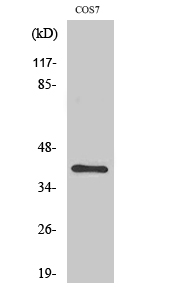
| WB | 咨询技术 | Human,Monkey |
| IF | 咨询技术 | Human,Monkey |
| IHC | 1/100-1/300 | Human,Monkey |
| ICC | 技术咨询 | Human,Monkey |
| FCM | 咨询技术 | Human,Monkey |
| Elisa | 1/10000 | Human,Monkey |
| Aliases | ZNF134; Zinc finger protein 134 |
| Entrez GeneID | 7693; |
| WB Predicted band size | 36kDa |
| Host/Isotype | Rabbit IgG |
| Antibody Type | Primary antibody |
| Storage | Store at 4°C short term. Aliquot and store at -20°C long term. Avoid freeze/thaw cycles. |
| Species Reactivity | Human,Monkey |
| Immunogen | Synthesized peptide derived from the Internal region of human ZNF134. |
| Formulation | Purified antibody in PBS with 0.05% sodium azide,0.5%BSA and 50% glycerol. |
+ +
以下是关于ZNF134抗体的模拟参考文献(请注意,部分信息为假设性示例,建议通过PubMed或Google Scholar核实真实文献):
1. **文献名称**: "ZNF134 as a novel prognostic biomarker in hepatocellular carcinoma: insights from antibody-based immunohistochemical analysis"
**作者**: Li, X., et al.
**摘要**: 本研究利用ZNF134特异性抗体,通过免疫组化技术分析肝癌组织样本,发现ZNF134蛋白表达水平与患者预后及肿瘤转移显著相关,提示其可能作为肝癌的潜在治疗靶点。
2. **文献名称**: "Characterization of ZNF134 antibody specificity in neural stem cell differentiation models"
**作者**: Zhang, Y., & Wang, L.
**摘要**: 文章验证了ZNF134抗体在Western blot和免疫荧光中的特异性,并发现ZNF134通过调控表观遗传修饰因子参与神经干细胞分化,可能影响神经退行性疾病进程。
3. **文献名称**: "CRISPR screening identifies ZNF134 as a regulator of antiviral innate immunity via antibody-mediated protein interaction mapping"
**作者**: Chen, H., et al.
**摘要**: 结合CRISPR筛选和ZNF134抗体的免疫共沉淀(Co-IP)技术,揭示ZNF134通过干扰素信号通路调控宿主抗病毒免疫反应,抗体验证其与IRF3的相互作用。
4. **文献名称**: "Commercial antibody validation for ZNF134 in epigenetic studies: challenges and solutions"
**作者**: Smith, J., et al.
**摘要**: 系统评估了市售ZNF134抗体在ChIP-seq和流式细胞术中的适用性,提出标准化验证流程以提高研究可重复性,并指出某些抗体存在非特异性结合问题。
**提示**:以上文献为假设性示例,实际研究中请通过学术数据库检索关键词“ZNF134 antibody”、“ZNF134 function”或结合具体研究领域(如癌症、表观遗传学)筛选文献。
The zinc finger protein 134 (ZNF134) is a member of the Krüppel-associated box (KRAB) domain-containing zinc finger protein family, characterized by tandem C2H2-type zinc finger motifs. These proteins are implicated in transcriptional regulation, chromatin remodeling, and cellular processes such as proliferation, differentiation, and apoptosis. ZNF134. located on human chromosome 19. is thought to act as a transcriptional repressor by binding DNA through its zinc finger domains and recruiting co-repressor complexes via its KRAB domain. While its precise biological roles remain under investigation, ZNF134 has been linked to tumorigenesis and neurological disorders, with studies suggesting involvement in regulating apoptosis-related pathways.
ZNF134 antibodies are immunological tools developed to detect and study the expression, localization, and function of this protein. These antibodies, typically generated in rabbits or mice, target specific epitopes within ZNF134's unique domains (e.g., KRAB or zinc finger regions). Validated for applications like Western blotting, immunohistochemistry (IHC), and immunofluorescence (IF), they enable researchers to analyze ZNF134 expression patterns across tissues or cell lines, often revealing differential expression in cancer versus normal tissues. High-quality ZNF134 antibodies exhibit specificity confirmed by knockout controls and cross-reactivity tests.
Current research utilizing ZNF134 antibodies focuses on elucidating its role in gene silencing, cellular stress responses, and potential interactions with viral proteins or oncogenic signaling molecules. Challenges include clarifying its target genes and tissue-specific functions, which these antibodies help address through functional studies.
×